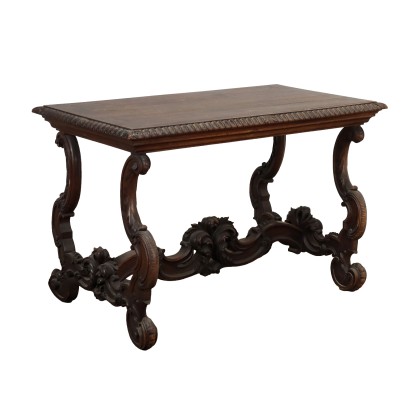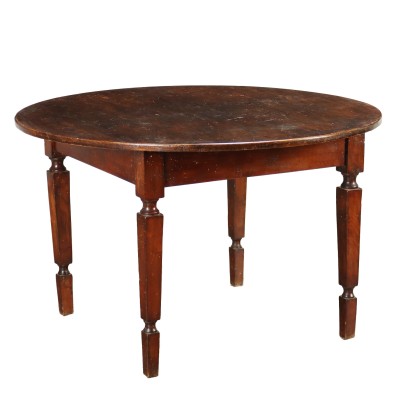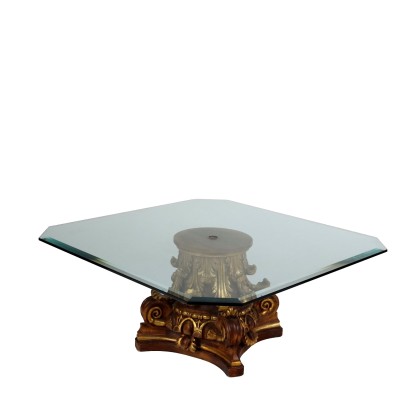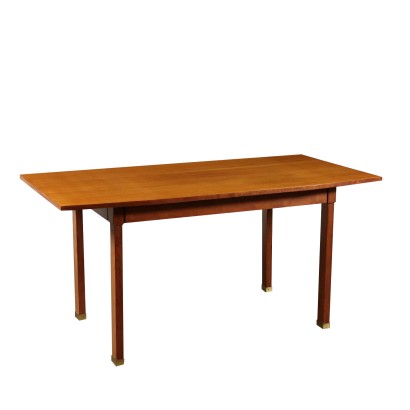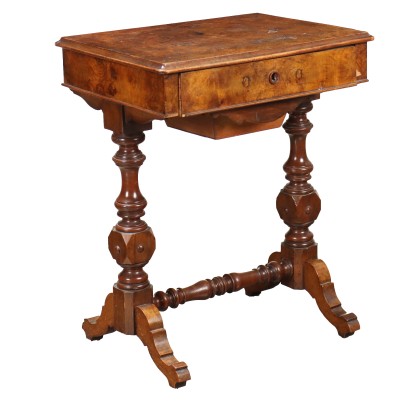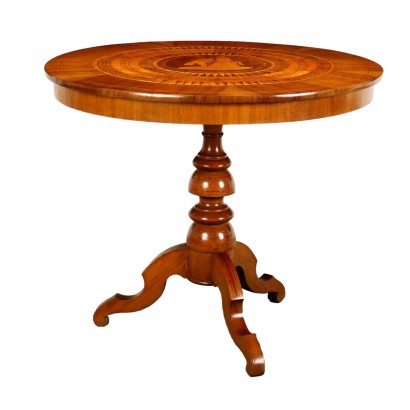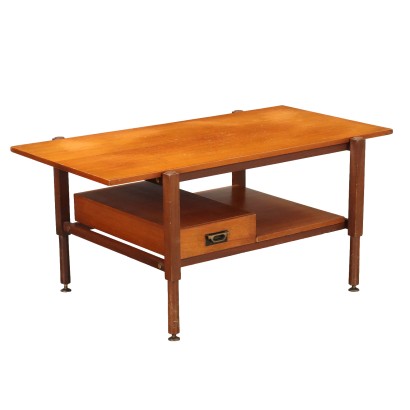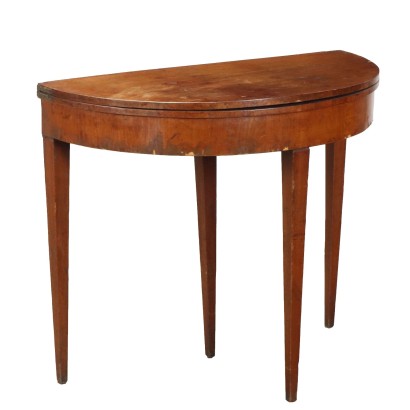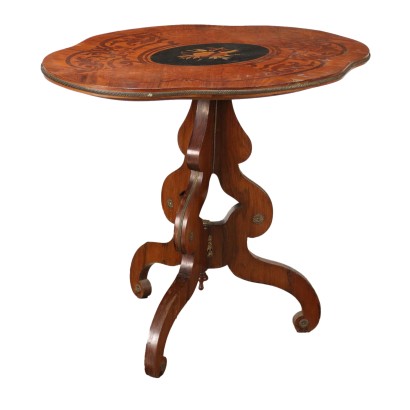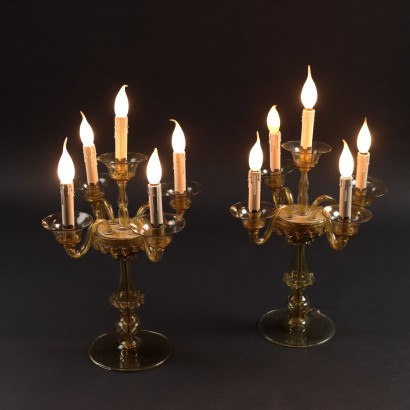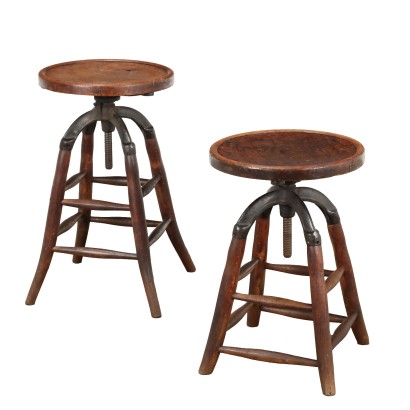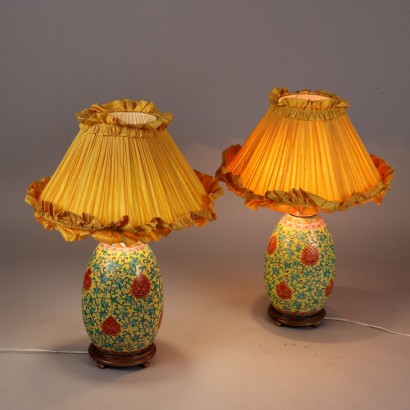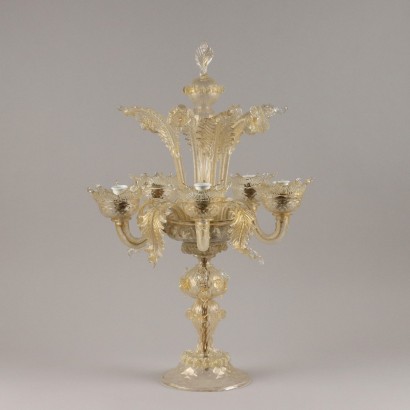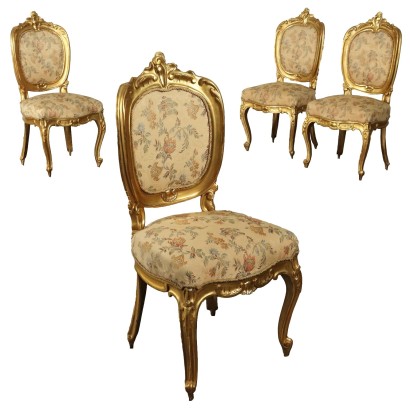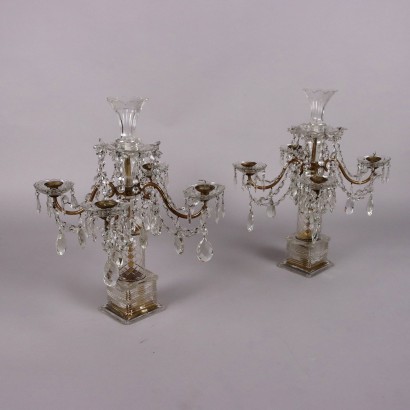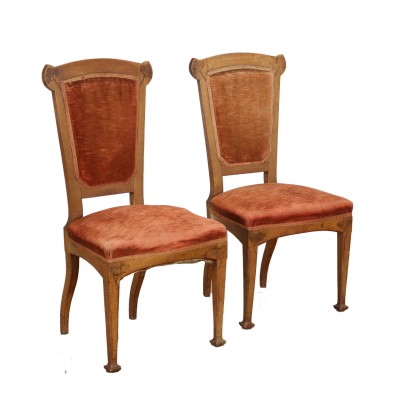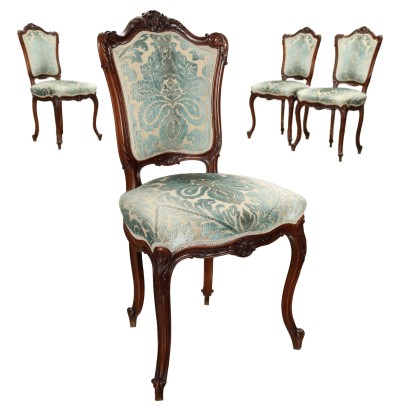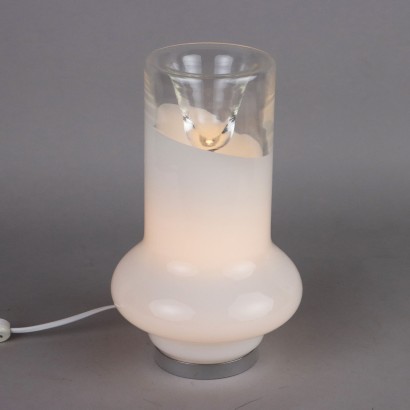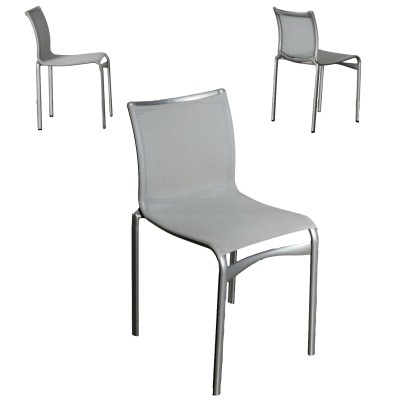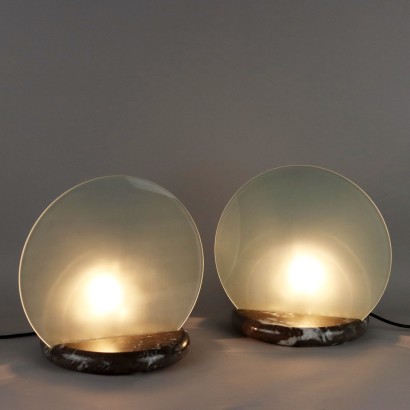Antique Neo-Baroque Table Walnut Decorations Italy XX Century - Italy, Early XIX Century
Features
Italy, Early XIX Century
Style: Neo-Baroque (1860-1890)
Age: 20th Century / 1901 - 2000
Origin: Italy
Main essence: Walnut
Description
Neo-Baroque table supported by carved lyre legs, connected by a moved crosspiece and also carved with leaf motifs.
Product Condition:
Product which due to age and wear requires restoration and re-polishing. We try to present the real state of the furniture as completely as possible with photos. If some details are not clear from the photos, what is stated in the description applies.
Dimensions (cm):
Height: 83
Width: 131
Depth: 70
Additional Information
Style: Neo-Baroque (1860-1890)
Anticipated in England in the first half of the 19th century on reminiscences of the Elizabethan style, it returns in vogue around 1870, but interpreted in a very free way.At the beginning it represents a response to the frivolity of the neo-rococo, but soon expires in a pompous and eclectic style that combines severe sixteenth-century elements with early seventeenth-century sculptural decorations.
The furniture is solid, richly carved and carved, in wood with a dark patina.
Masks, cornices, columns carved with herms that make up typical architectural structures of Renaissance palaces, are the elements that characterize the neo-Renaissance style.
It was an era in which we saw the revival and the revival of ancient forms with a typically Renaissance taste, large carvings were used for an all-round, deeper and three-dimensional vision, the use of feral legs in the caissons and in the wardrobes, squares and moldings, frames, ashlar and nails, Romanesque ornamental motifs but also acanthus leaves, cartouches and lion heads.
Often in this period the furniture is built using ancient materials and parts of Renaissance furniture.
Walnut was often used but also less hard essences such as poplar or others since they were often darkened and presented in black.
Find out more with the insights of our blog:
The Neobarocco in a large table of '800
Age: 20th Century / 1901 - 2000
20th Century / 1901 - 2000Main essence: Walnut
Walnut wood comes from the plant whose botanical name is juglans regia , probably originally from the East but very common in Europe. Light or dark brown in color, it is a hard wood with a beautiful grain, widely used in antique furniture. It was the main essence in Italy throughout the Renaissance and later had a good diffusion in Europe, especially in England, until the advent of mahogany. It was used for solid wood furniture and sometimes carvings and inlays, its only big limitation is that it suffers a lot from woodworm. In France it was widely used more than anything else in the provinces. In the second half of the eighteenth century its use decreased significantly because mahogany and other exotic woods were preferred.Other customers have searched:
Tavolo, tavoli antiquariato, tavolo antico..
Approfondimenti
Se ti interessano tavoli, tavolini, tavoli a vela, scrivanie, scrittoi e consolle dai un'occhiata ai nostri approfondimenti sul blog...
Classic Monday: da un pezzo dei nostri magazzini alla storia dell'antiquariato
L'antiquariato dalla A alla Z: il Dizionario dell'Antiquariato
Il dizionario dell'antiquariato - Lastronatura
Il dizionario dell'antiquariato - Mascherone
Il dizionario dell'antiquariato - Natura morta
Il dizionario dell'antiquariato - Opificio
Il dizionario dell'antiquariato - Pastiglia
Il dizionario dell'antiquariato - Savonarola
Il dizionario dell'antiquariato - Rosone
Due eccezionali scrivanie di produzione lombarda
Uno scrittoio San Filippo dalle forme eleganti e ricercate
Intaglio barocco con motivo a ricciolo
Sui tavoli:
Il Neobarocco in un grande tavolo dell'800
Il Tavolo a fratino
Sui tavolini:
Breve storia dei tavolini
Un tavolino impero lombardo: segno di egemonia politica
Il tavolino da gioco, questo sconosciuto
Il dizionario dell'antiquariato – tavolino a Commesso
Sulle consolle:
Una superba consolle austriaca
L'attenzione neoclassica per i dettagli in una consolle torinese decorata a pastiglia
Una raffinata consolle demi-lune piemontese neoclassica
L'estetica elegante e raffinata di una Consolle fratinata
Simili ma diverse: una consolle Luigi Filippo e una umbertina a confronto
...e alle presentazioni su FineArt
Tavoli antichi:
Tavolo campionario lapideo, Roma, Opificio Raffaelli
Tavolo a vela, attribuibile a Luigi e Angiolo Falcini
Tavolo attribuibile a Luigi e Angiolo Falcini
Gueridon, Regno delle Due Sicilie, primo quarto XIX secolo
Tavoli modernariato e design:
Archivio Borsani, patrimonio di memorie e saperi
Tavolo anni '40 ABV
Tavolo Mario Vender Anni '60
Tavolo anni '50 ABV
Tavolo '522' Gianfranco Frattini per Bernini
Tavolo 'Barium' Luciano Frigerio
Tavolo anni '50, Manifattura Italiana
Scrittoi e scrivanie:
Scrivania Anni '50
Scrittoio, Marco Calestrini, Firenze, ultimo quarto del XVIII secolo
Scrittoio, Antonio Mascarone, inizi XIX secolo
Scrittoio, Arthur Blain, Liverpool 1840 ca.
Scrittoio a dorso d'asino, Piacenza, metà XVIII secolo
Scrittoio, Antonio Mascarone, inizi XIX secolo
Consolle e tavoli parietali:
Consolle a pastiglia
Tavolo parietale, Firenze 1780-1785ca.
Consolle inglese, metà XIX secolo
Consolle parietale
Coppia di consolle in pietre laviche
Consolle anni '50, manifattura italiana
Tavolini antichi:
Coppia di tavolini Tomaso Buzzi, attribuiti
Tavolino da gioco, Bottega Giuseppe Maggiolini, inizi XIX secolo
Tavolino piano commesso, Toscana, Inghilterra, Metà XIX Secolo
Tavolino Piano Commesso, Amic Hotton (attribuito a ), XIX Secolo
Tavolini modernariato:
Tavolino anni '50
Tavolino anni '40 ABV
Tavolino anni '60
Approfondimenti
Se ti interessano tavoli, tavolini, tavoli a vela, scrivanie, scrittoi e consolle dai un'occhiata ai nostri approfondimenti sul blog...Classic Monday: da un pezzo dei nostri magazzini alla storia dell'antiquariato
L'antiquariato dalla A alla Z: il Dizionario dell'Antiquariato
Il dizionario dell'antiquariato - Lastronatura
Il dizionario dell'antiquariato - Mascherone
Il dizionario dell'antiquariato - Natura morta
Il dizionario dell'antiquariato - Opificio
Il dizionario dell'antiquariato - Pastiglia
Il dizionario dell'antiquariato - Savonarola
Il dizionario dell'antiquariato - Rosone
Due eccezionali scrivanie di produzione lombarda
Uno scrittoio San Filippo dalle forme eleganti e ricercate
Intaglio barocco con motivo a ricciolo
Sui tavoli:
Il Neobarocco in un grande tavolo dell'800
Il Tavolo a fratino
Sui tavolini:
Breve storia dei tavolini
Un tavolino impero lombardo: segno di egemonia politica
Il tavolino da gioco, questo sconosciuto
Il dizionario dell'antiquariato – tavolino a Commesso
Sulle consolle:
Una superba consolle austriaca
L'attenzione neoclassica per i dettagli in una consolle torinese decorata a pastiglia
Una raffinata consolle demi-lune piemontese neoclassica
L'estetica elegante e raffinata di una Consolle fratinata
Simili ma diverse: una consolle Luigi Filippo e una umbertina a confronto
...e alle presentazioni su FineArt
Tavoli antichi:
Tavolo campionario lapideo, Roma, Opificio Raffaelli
Tavolo a vela, attribuibile a Luigi e Angiolo Falcini
Tavolo attribuibile a Luigi e Angiolo Falcini
Gueridon, Regno delle Due Sicilie, primo quarto XIX secolo
Tavoli modernariato e design:
Archivio Borsani, patrimonio di memorie e saperi
Tavolo anni '40 ABV
Tavolo Mario Vender Anni '60
Tavolo anni '50 ABV
Tavolo '522' Gianfranco Frattini per Bernini
Tavolo 'Barium' Luciano Frigerio
Tavolo anni '50, Manifattura Italiana
Scrittoi e scrivanie:
Scrivania Anni '50
Scrittoio, Marco Calestrini, Firenze, ultimo quarto del XVIII secolo
Scrittoio, Antonio Mascarone, inizi XIX secolo
Scrittoio, Arthur Blain, Liverpool 1840 ca.
Scrittoio a dorso d'asino, Piacenza, metà XVIII secolo
Scrittoio, Antonio Mascarone, inizi XIX secolo
Consolle e tavoli parietali:
Consolle a pastiglia
Tavolo parietale, Firenze 1780-1785ca.
Consolle inglese, metà XIX secolo
Consolle parietale
Coppia di consolle in pietre laviche
Consolle anni '50, manifattura italiana
Tavolini antichi:
Coppia di tavolini Tomaso Buzzi, attribuiti
Tavolino da gioco, Bottega Giuseppe Maggiolini, inizi XIX secolo
Tavolino piano commesso, Toscana, Inghilterra, Metà XIX Secolo
Tavolino Piano Commesso, Amic Hotton (attribuito a ), XIX Secolo
Tavolini modernariato:
Tavolino anni '50
Tavolino anni '40 ABV
Tavolino anni '60
Product availability
The product can be seen at Cambiago
Immediate availability
Ready for delivery within 2 working days from ordering the product.



